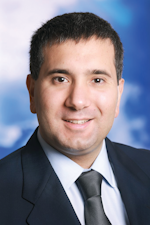Airport infrastructure is often overlooked when considering the safety of the apron environment, and little can be done in the short term to change airport design. When airport projects do materialize, however, designers should engineer safety features to prevent aircraft ground damage, such as avoiding intersections between aircraft taxiways and lanes dedicated to ground support vehicles as well as reducing GSE traffic around aircraft.
According to David Stewart, head of airport development at the International Air Transport Association (IATA) new airports and major expansions to existing airports in South America are being designed with close consideration to international standards regarding ramp layouts and GSE requirements as recommended by ICAO, IATA and other industry and regulatory bodies. “The new terminals in Bogota, Quito, Sao Paulo and Rio de Janeiro and the new terminal under development in Santiago all adhere to international standards,” Stewart says.
Santiago’s Arturo Marino Benítez (AMB) airport represents one of the main airport infrastructure overhauls in South America. Nuevo Pudahuel is the operator of Santiago AMB and it acts as a consortium integrated by Aéroports de Paris, VINCI Airports and Astaldi Concessioni; the consortium is building a 175,000 square meter new terminal. The new building, a USD 900 million investment, will increase the airport’s capacity to 30 million passengers in 2020, a significant increase compared to the 17 million passengers travelling through Santiago airport in 2015; the traffic figure corresponds to a 7.2 percent increase on 2014, a growth rate which goes in line with Nuevo Pudahuel’s projections.
Xavier Lortat-Jacob is the Chief Technical Officer (CTO) of Nuevo Pudahuel; he says that the consortium is currently focussed on the design of Santiago airport’s new terminal and the infrastructure is being design taking into account resilience to future traffic evolution but also operational constraints and safety requirements. “The purpose is to promote the operational safety policy that is driving our company and our parent companies in all of their worldwide airport projects. We recognise through our experience that risks are concentrated in the movement and parking area where ground handlers are working in close proximity around the aircraft. In order to reduce and avoid ground damage as far as possible we are of course intervening on airport infrastructure design but also on airport operations,” Lortat-Jacob says.
Avoiding mix aircraft and GSE traffic
As part of the new airport development projects in South America efforts are being committed to avoid a mixed aircraft and GSE traffic on the apron, and specifically with the realisation of lanes for ground support vehicles that do not cross taxiways, possibly built underneath them.
“Within existing physical constraints airport expansions and certainly new terminal developments are being built to international standards,” Stewart says. “Dedicated circulation lanes are integrated into the apron design and separate internal airside road networks are being included in the design of new airfield systems.”
According to Lortat-Jacob the design currently under development of Santiago’s airport expansion is providing a dedicated service road network, out of the taxi lane/taxiway clearance and the possibility to service the aircraft stands both from the front and from the rear. “This redundancy allows avoiding bottlenecks on the service road network and ensures smooth operations in the aircraft parking area. The service road network circles the passenger terminal area, providing for a two-way flow of vehicles without having to cross in the process a taxiway or taxi lane and reducing risk of ground damage.” Lortat-Jacob says.
Fixed ground support installations
Another consideration driving airport design for improved resilience against ground damage is the development of aircraft stands with fixed ground support installations that reduce GSE movements around aircraft and thus the likelihood of damage.
Cavotec is a manufacturer of ground support equipment, such as 400hz convertors, PCA machines, utility and fuel pit system, used to service aircraft at contract gates, remote aprons and hangars. According to Gary Matthews, group market unit manager for aviation at Cavotec, the company has seen a rise in recent years of requests for fixed ground systems from Central and South America.
Wherever physically practical, fixed ground power and air conditioning units are being included as new aircraft parking stands are being developed. Generally the approach is to include these facilities as part of new and replacement air bridge installations, according to Stewart.
Lortat-Jacob notes that Santiago Airport is currently equipped with a fuel hydrant network servicing both contact and remote aircraft stands. In the future, all contact aircraft stands will also be equipped with 400hz convertors and PCA in addition to the fuel hydrant system, he says.
Fixed ground support installations surely have a safety benefit, but are more expensive to build. There is a need to justify a higher capital expenditure and due consideration must be given to when break-even can be reached. According to Matthews, environmental concerns, ease of operations, improved security, reduced ramp personnel, increased efficiency and productivity, reduced energy costs, rescued fleet costs, quicker turnaround times and reduced APU usage all need to be weighed in to justify capital expenditures.
In the experience of Santiago’s airport there are several considerations that must be taken into account in order to justify an investment: safety and regulatory requirements but also operational needs and efficiency. “The amount is pondered and assessed in a complex process ensuring that the best choice is made in terms of technology, resilience and safety,” Lortat-Jacob says.
“The cost/benefit analysis for the installation of fixed air/power differs by airport and also depends on the structure of airport charges which also tend to differ by airport. However, the payback is usually based on how the capital expenditure is depreciated over time” says Stewart.
The breakeven point depends on many factors including the number of gate, optimisation, usage, type of system, local energy costs, fuel costs, local ambient environment, according to Matthews.
Improving GSE utilisation
One additional solution – which is currently not very frequently implemented across the world’s big hubs – could be for airport operators to own ground support equipment (e.g. passenger buses) and rent them out to ground handling companies to improve asset utilisation and traffic patterns on the apron, and thus the likelihood of damage. Can this be a promising a solution for South America?
Stewart believes that there are issues to consider about who is responsible for maintenance and possible damage to the equipment. “Where will liability lie and how will this be adjudicated? However if there is a strong business case that evaluates operational efficiency and a cost advantage then this could be considered as a potential option,” he says.
Looking ahead
International standards are already in place to support safety and operational efficiency on airport aprons and taxiways, according to Stewart, and these are being complied as part of the major infrastructural (re)developments in South America. “The most effective way to ensure that these conditions are being met is to hire professional consultants with the appropriate credentials and experience during the design phase of a project and then be careful when weighing potential ‘value engineering’ savings. Safety should never be compromised,” Stewart says.
The same remark is shared by Lortat-Jacob: “Airport design should be driven by best industry practices taking into account local particularities and room for future expansion. Therefore, the involvement of informed designers and experienced operators is essential in order to ensure the result shall be resilient to future practices,” he says.
Andrew Price, head of airport operations at IATA, believes that a focus on the safety culture should be among the additional considerations to complement airport design to make the system more resilient to aircraft damage on the apron. “Having a no blame culture for reporting accidental damage is important as the safety of the aircraft has to take priority over the allocation of fault. The second thing is keeping tarmacs clear of debris to reduce FOD. Having a policy of ‘pick it up and bin it’ helps reduce this. Both items are simple, effective and cheap,” Price says.





